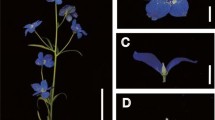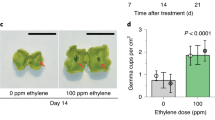Abstract
Ethylene production and expression patterns of an 1-aminocyclopropane-1-carboxylic acid (ACC) oxidase (CARAO1) and of two ACC synthase (EC 4.4.1.14) genes (CARACC3 and CARAS1) were studied in floral organs of cut carnation flowers (Dianthus caryophyllus L.) cv. White Sim. During the vase life and after treatment of fresh flowers with ethylene, production of ethylene and expression of ethylene biosynthetic genes first started in the ovary followed by the styles and the petals. ACC oxidase was expressed in all the floral organs whereas, during the vase life, tissue-specific expression of the two ACC synthase genes was observed. After treatment with a high ethylene concentration, tissue specificity of the two ACC synthase genes was lost and only a temporal difference in expression remained. In styles, poor correlation between ethylene production and ACC synthase (CARAS1) gene expression was observed suggesting that either activity is regulated at the translational level or that the CARAS1 gene product requires an additional factor for activity.
Isolated petals showed no increase in ethylene production and expression of ethylene biosynthetic genes when excised from the flower before the increase in petal ethylene production (before day 7); showed rapid cessation of ethylene production and gene expression when excised during the early phase of petal ethylene production (day 7) and showed a pattern of ethylene production and gene expression similar to the pattern observed in the attached petals when isolated at day 8. The interorgan regulation of gene expression and ethylene as a signal molecule in flower senescence are discussed.
Similar content being viewed by others
References
Botella JR, Arteca JM, Schlagnhaufer CD, Arteca RN, Phillips AT: Identification and characterization of a full-length cDNA encoding for an auxin-induced 1-aminocyclopropane-1-carboxylate synthase from etiolated mung bean hypocotyl segments and expression of its mRNA in response to indole-3-acetic acid. Plant Mol Biol 20: 425-436 (1992).
Burg SP, Dijkman MJ: Ethylene and auxin parti-cipation in pollen induced fading of Vandaorchids. Plant Physiol 42: 1648- 1650 (1967).
Drory A, Mayak S, Woodson WR: Expression of ethylene biosynthetic pathway mRNAs is spatially regulated within carnation flower petals. J Plant Physiol 141: 663-667 (1993).
Felix G, Regenass M, Spanu P, Boller T: The protein phosphatase inhibitor calyculin A mimics elicitor action in plant cells and induces rapid hyperphosphorylation of specific proteins as revealed by pulse labeling with [33P]phosphate. Proc Natl Acad Sci USA 91: 952-956 (1994).
Henskens JAM, Rouwendal GJA, ten Have A, Woltering EJ: Molecular cloning of two different ACC synthase PCR fragments in carnation flowers and organ-specific expression of the corresponding genes. Plant Mol Biol 26: 453-458 (1994).
Kende H: Ethylene biosynthesis. Annu Rev Plant Physiol Plant Mol Biol 44: 283-307 (1993).
Linskens HF, Spanjers AW: Changes in the electrical potential in the transmitting tissue of Petuniastyles after cross-and selfpollination. Incompat Newsl 3:81-85 (1973).
Mehta K, Hale TI, Christen P: Evolutionary relationships among aminotransferases. Eur J Biochem 189: 249-253 (1989).
Nadeau JA, Zhang XS, Nair H, O'Neill SD: Temporal and spatial regulation of 1-aminocy-clopropane-1-carboxylate oxidase in the pollination-induced senescence of orchid flowers. Plant Physiol 103: 31-39 (1993).
Nichols R, Bufler G, Mor Y, Fujino W, Reid MS: Changes in ethylene production and 1-aminocycloprane-1-carboxylic acid content of pollinated carnation flowers. J Plant Growth Regul 2: 1-8 (1983).
Nijenhuis-de Vries MA, Woltering EJ, De Vrije T: Partial characterization of carnation petal 1-aminocyclopropane-1-carboxylate oxidase. J Plant Physiol 144: 549-554 (1994).
O'Neill SD, Nadeau JA, Zhang XS, Bui AQ, Halevy AH: Interorgan regulation of ethylene biosynthetic genes by pollination. Plant Cell 5: 419-432 (1993).
Overbeek JHM, Woltering EJ: Synergistic effect of 1-aminocyclopropane-1-carboxylic acid and ethylene during senescence of isolated carnation petals. Physiol Plant 79: 368- 376 (1990).
Park KY, Drory A, Woodson WR: Molecular cloning of an 1-aminocyclopropane-1-carboxylate synthase from senescing carnation flower petals. Plant Mol Biol 18: 377-386 (1992).
Reid MS, Fujino DW, Hoffman NE, Whitehead CS: 1-aminocyclopropane-1-carboxylic acid (ACC): the transmitted stimulus in pollinated flowers. J Plant Growth Regul 3: 189- 196 (1984).
Rottmann WH, Peter GF, Oeller PW, Keller JA, Shen NF, Nagy BP, Taylor P, Campbell AD, Theologis A: 1-Aminocyclopropane-1-carboxylate synthase in tomatao is encoded by a multigene family whose transcription is induced during fruit and floral senescence. J Mol Biol 222: 937-961 (1991).
Sacalis JN: Effect of gynoecium excision on auxin-mediated promotion of petal senescence in cut carnation flowers. J Plant Physiol 133: 734-737 (1989).
Sacalis JN, Lee JS: Promotion of floral longevity by the ovary in carnation flowers. J Am Soc Hort Sci 112: 118-121 (1987).
Sambrook J, Fritsch EF, Maniatis T: Molecular Cloning: A Laboratory Manual, 2nd ed. Cold Spring Harbor Laboratory Press, Cold Spring Harbor, NY (1989).
Spanu P, Grosskopf DG, Felix G, Boller T: The apparent turnover of 1-aminocyclopropane-1-carboxylate synthase in tomato cells is regulated by protein phosphorylation and dephosphorylation. Plant Physiol 106: 529-535 (1994).
Tabor CW, Tabor H: Methionine adenosyl transferase (S-adenosylmethionine synthethase) and S-adenosylmethionine decarboxylase. Adv Enzymol 56: 251-282 (1984).
Tang X, Gomes AMTR, Bhatia A, Woodson WR: Pistil-specific and ethylene-regulated expression of 1-aminocyclopropane-1-carboxylate oxidase genes in petunia flowers. Plant Cell 6: 1227-1239 (1994).
Wang H, Woodson WR: A flower sensescence-related mRNA from carnation shares sequence similarity with fruit ripeningrelated mRNAs involved in ethylene biosynthesis. Plant Physiol 96: 1000-1001 (1991).
Whitehead CS, Halevy AH: Ethylene sensitivity: The role of short-chain saturated fatty acids in pollination-induced senescence of Petunia hybridaflowers. Plant Growth Regul 8: 41-54 (1989).
Woltering EJ: Interorgan translocation of 1-aminocyclopropane-1carboxylic acid and ethylene coordinates senescence in emasculated Cymbidiumflowers. Plant Physiol 91: 837-845 (1990).
Woltering EJ, Somhorst D, De Beer CA: Roles of ethylene production and sensitivity in senescence of carnation flower (Dianthus caryophyllus) cultivars White Sim, Chinera, and Epomeo. J Plant Physiol 141: 329-335 (1993).
Woltering EJ, Somhorst D, Van der Veer P: The role of ethylene in interorgan signaling during flower senescence. Plant Physiol 109: 1219-1225 (1995).
Woltering EJ, Ten Have A, Larsen PB, Woodson WR: Ethylene biosynthetic genes and interorgan signalling during flower senescence. In: Scott RJ, Stead AD (eds): Molecular and Cellular Aspects of Plant Reproduction, pp. 287-309. Society for Experimental Biology Seminar Series 55. Cambridge University Press, Cambridge (1994).
Woodson WR, Brandt AS: Role of the Gynoeciumin cytokinininduced carnation petal senescence. J Am Soc Hort Sci 116: 676-679 (1991).
Woodson WR, Park KY, Drory A, Larsen PB, Wang H: Expression of ethylene biosynthetic pathway transcripts in senescing carnation flowers. Plant Physiol 99: 526-532 (1992).
Yang SF, Hoffman NE: Ethylene biosynthesis and its regulation in higher plants. Annu Rev Plant Physiol 35: 155-189 (1984).
Zarembinsky TI, Theologis A: Ethylene biosynthesis and action: a case of conservation. Plant Mol Biol 26: 1579-1597 (1994).
Author information
Authors and Affiliations
Rights and permissions
About this article
Cite this article
ten Have, A., Woltering, E.J. Ethylene biosynthetic genes are differentially expressed during carnation (Dianthus caryophyllus L.) flower senescence. Plant Mol Biol 34, 89–97 (1997). https://doi.org/10.1023/A:1005894703444
Issue Date:
DOI: https://doi.org/10.1023/A:1005894703444




